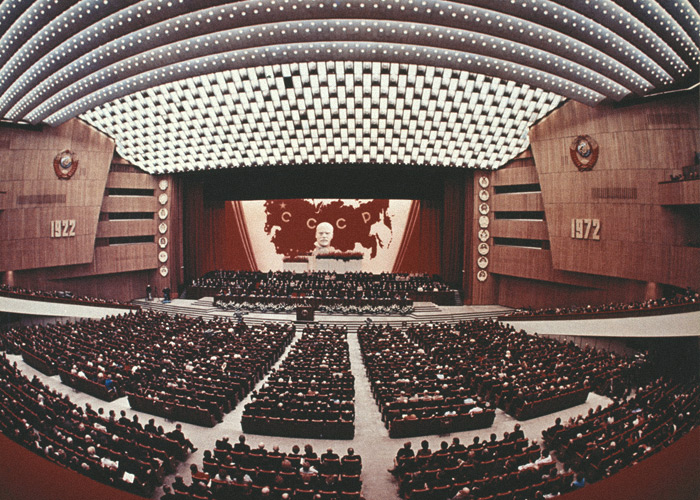Course #4 / The World of Tarkovsky

Due to emigration to Italy in the last years of his life, Tarkovsky has been often portrayed as a dissident or an oppressed artist. However, many researchers (or even students who just want to complete their movie critique essay) often discover that this was a serious misconception. In reality, he never really tried to publicly oppose the Soviet Union. Sometimes artists use their art to send a message or show their stance against a particular country or political system. Tarkovsky was a pure artist; his films did not have any hidden politically oriented messages.
Of course, the Soviet Union was a country that had strict guidelines in many areas. Art and cinema was no exception. For an artist to get his work published and exposed for a general audience there was always a certain committee reviewing it. Filmmaking was the responsibility of Goskino (USSR State Committee for Cinematography). It was responsible for the allocation of the government’s funds for the approved movie projects. If the scenario of the movie was good enough and it did not undermine the Communism ideals and Soviet values – it got the approval and the director had a chance to realize his idea.
Tarkovsky was no exception. Rules were the same for everyone. However, he often had a long way to approval from the authorities and there is a simple explanation. His movies were spiritual and included different religious motifs. Since the Soviet Union had an official atheist ideology, religious themes were clearly a bad choice to get quick approval. This is why Tarkovsky had to be sly to convince the Goskino and get a green light for the start of the production of his movies. You also need to keep in mind that everything in the Soviet Union was state-owned and movies were not commercial projects with a goal to bring income as it is nowadays.
Censorship in films and different art forms might be seen as a negative thing. In a case with Tarkovsky and the Soviet Union, this actually was a good thing. When a director has a certain idea and vision for his movie, but Goskino suggests him to make some changes, it creates a challenge. Iconic artworks are rarely created in greenhouse conditions. Even if you compare the two final movies Tarkovsky directed in Italy and Sweden to those five he made in the Soviet Union, you will not notice any differences in terms of quality. Soviet cinematography at all times produced quality movies; a lot of them can be called masterpieces. Because of censorship, there were rarely bad movies produced. Some were just good, some average; however, there were no bad quality films without any artistic value. Standards back then were different. Nowadays directors might have more freedom, but they have to sell their movies as well. A commercial factor often destroys the artistic value and movie simply becomes purely a business venture.
Despite Tarkovsky had a lot of envious and detractors in Goskino and Soviet cinematic community, his movies still got constant support and funding. His famous movie Andrei Rublev (1966) had a budget of more than 1 million rubles – a significant sum for that period. When the first version of Stalker was lost, there were allocated additional funds to complete it. Producing of Nostalghia in a foreign country was initially supported by the Soviet Union as well. Considering fact that 99.9% of the Soviet citizens had zero chance to visit a foreign, and what is even more important – a capitalist state in their lifetime, Tarkovsky was one of the few privileged ones.
Taking into consideration all these facts, there is no reason to view Tarkovsky as some kind of government oppressed artist. The Soviet Union had a great theatre and cinema traditions, all directors had to face the same kind of problems and challenges. Tarkovsky was a hot-tempered and a bit controversial figure. He often was involved in conflicts with the crew he worked together on films; his perfectionist nature was not easy to cope with. It is understandable that eventually, he saw the opportunity to stay in Italy, try to work in a different environment and system, where censorship does not exist. He was a popular and respected director outside USSR. However, his last two movies clearly show that life in the capitalist West was not as sweet as it seemed back in the Soviet Union. A true nostalgia had its place. In the era of misconceptions and stereotypes, those Soviet citizens, who had the rare opportunity to visit the West and know a bit more about life in the capitalist system, were often caught in different illusions. Of course, capitalism gave the opportunity to earn more and be more independent; however, there were plenty of challenges as well. Every system has its flaws and capitalism is no exception. Many people could not adapt to the new system after the dissolution of the Soviet Union, because they were used to the support from the state.
It is a topic for a debate about how Tarkovsky’s career would go on if he would be born in the West. Maybe he would blossom, even more, maybe a less challenging environment would limit his growth. The question remains open. Nevertheless, Tarkovsky wrote his name in the history of the cinematography as a Soviet-born director and censorship did not take away his opportunities to create all these masterpieces.
Sources | Андрей Тарковский. Мартиролог. Дневники (2008) | Майя Туровская. 7 1/2 или фильмы Андрея Тарковского (1991) | Ярослав Ярополов. Андрей Тарковский. Сталкер мирового кино (2016)

